Accept all cookies Accept only essential cookies See our Cookie Notice

About ESA
The European Space Agency (ESA) is Europe’s gateway to space. Its mission is to shape the development of Europe’s space capability and ensure that investment in space continues to deliver benefits to the citizens of Europe and the world.
Highlights
ESA - United space in Europe
This is ESA ESA facts Member States & Cooperating States Funding Director General Top management For Member State Delegations European vision European Space Policy ESA & EU Space Councils Responsibility & Sustainability Annual Report Calendar of meetings Corporate newsEstablishments & sites
ESA Headquarters ESA ESTEC ESA ESOC ESA ESRIN ESA EAC ESA ESAC Europe's Spaceport ESA ESEC ESA ECSAT Brussels Office Washington OfficeWorking with ESA
Business with ESA ESA Commercialisation Gateway Law at ESA Careers Cyber resilience at ESA IT at ESA Newsroom Partnerships Merchandising Licence Education Open Space Innovation Platform Integrity and Reporting Administrative Tribunal Health and SafetyMore about ESA
History ESA Historical Archives Exhibitions Publications Art & Culture ESA Merchandise Kids Diversity ESA Brand Centre ESA ChampionsLatest
Space in Member States
Find out more about space activities in our 23 Member States, and understand how ESA works together with their national agencies, institutions and organisations.
Science & Exploration
Exploring our Solar System and unlocking the secrets of the Universe
Go to topicAstronauts
Missions
Juice Euclid Webb Solar Orbiter BepiColombo Gaia ExoMars Cheops Exoplanet missions More missionsActivities
International Space Station Orion service module Gateway Concordia Caves & Pangaea BenefitsSpace Safety
Protecting life and infrastructure on Earth and in orbit
Go to topicAsteroids
Asteroids and Planetary Defence Asteroid danger explained Flyeye telescope: asteroid detection Hera mission: asteroid deflection Near-Earth Object Coordination CentreSpace junk
About space debris Space debris by the numbers Space Environment Report In space refuelling, refurbishing and removingSafety from space
Clean Space ecodesign Zero Debris Technologies Space for Earth Supporting Sustainable DevelopmentLatest
Applications
Using space to benefit citizens and meet future challenges on Earth
Go to topicObserving the Earth
Observing the Earth Future EO Copernicus Meteorology Space for our climate Satellite missionsCommercialisation
ESA Commercialisation Gateway Open Space Innovation Platform Business Incubation ESA Space SolutionsLatest
Enabling & Support
Making space accessible and developing the technologies for the future
Go to topicBuilding missions
Space Engineering and Technology Test centre Laboratories Concurrent Design Facility Preparing for the future Shaping the Future Discovery and Preparation Advanced Concepts TeamSpace transportation
Space Transportation Ariane Vega Space Rider Future space transportation Boost! Europe's Spaceport Launches from Europe's Spaceport from 2012Latest
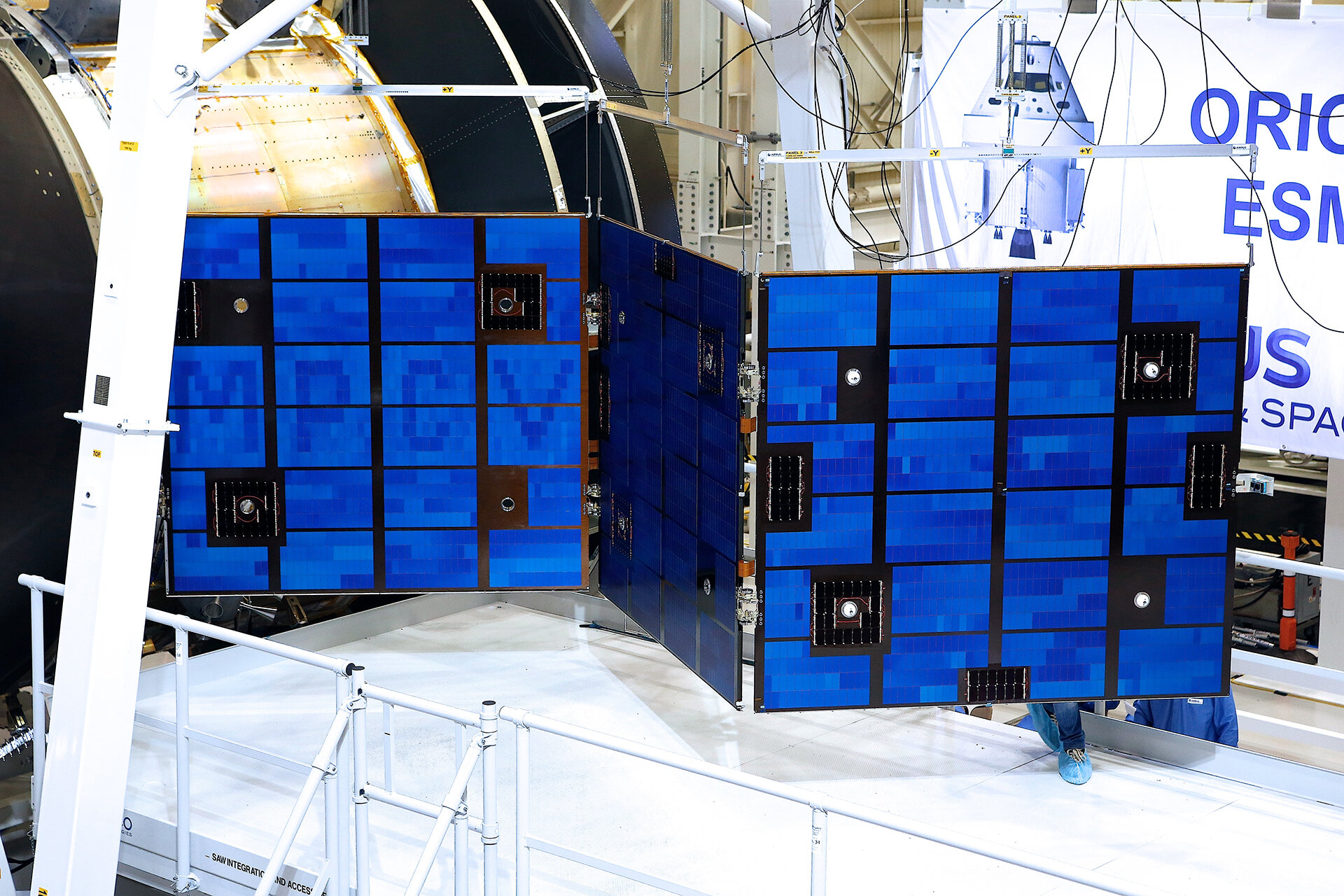
Orion’s wings
Thank you for liking
You have already liked this page, you can only like it once!
On 29 February a test model of Orion’s solar array was unfolded at NASA’s Plum Brook Station test facility in Sandusky, Ohio to check everything works as expected. The solar panels were made by Airbus Defence and Space in the Netherlands for the ESA module that will supply power and life support for up to four astronauts.
Each wing stretches more than 7 m, folded inside the Space Launch Systems rocket that will launch the spacecraft on its first unmanned mission in 2018. Orion sports four wings of three panels with 1242 cells per panel to provide 11.1 kW of power – enough to run two typical European households. The distinctive X-wings are an evolution and improvement of ESA’s Automated Transfer Vehicle.
The test was passed with flying colours as the 260 kg array unfurled into its flight configuration. The stresses of flying to the Moon and beyond – and back again – mean the array is designed to bend up to 60º forward and backward, much like a bird in flight.
“That broad movement meant we had to design the wing with thickened solar panels and reinforced hinges and beams, which required extensive testing,” says Arnaud de Jong, head of the Airbus Defence and Space Solar Array team in Leiden, the Netherlands.
The wing tips are expected to deflect more than a metre. A camera on each wing tip, looking back at the spacecraft, will closely monitor the movement.
Further tests will look at how the solar array handles acoustic shocks, vibrations and other shock tests in the following months.
Read more about Orion on ESA’s website or on the ESA’s Orion blog for regular updates, including a video of yesterday’s unfurling.
-
CREDIT
Airbus -
LICENCE
ESA Standard Licence
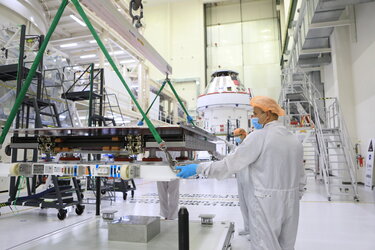
Installing solar wings on Orion

Installing solar wings on Orion
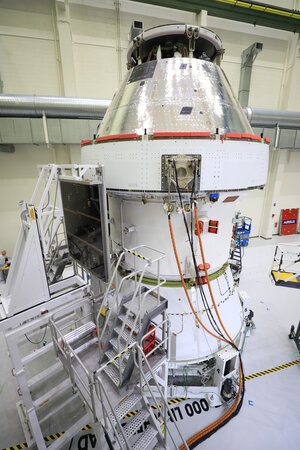
Orion with wings
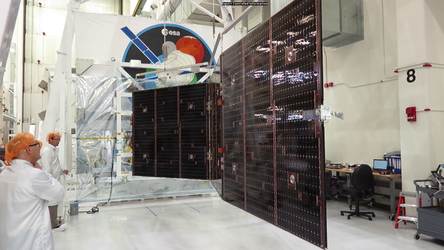
Orion spreads its wings
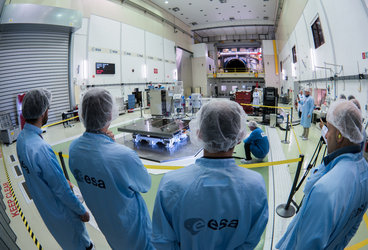














 Germany
Germany
 Austria
Austria
 Belgium
Belgium
 Denmark
Denmark
 Spain
Spain
 Estonia
Estonia
 Finland
Finland
 France
France
 Greece
Greece
 Hungary
Hungary
 Ireland
Ireland
 Italy
Italy
 Luxembourg
Luxembourg
 Norway
Norway
 The Netherlands
The Netherlands
 Poland
Poland
 Portugal
Portugal
 Czechia
Czechia
 Romania
Romania
 United Kingdom
United Kingdom
 Slovenia
Slovenia
 Sweden
Sweden
 Switzerland
Switzerland

























